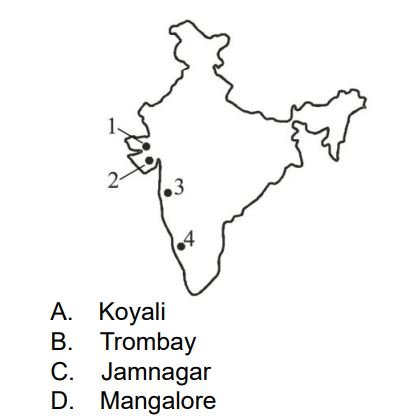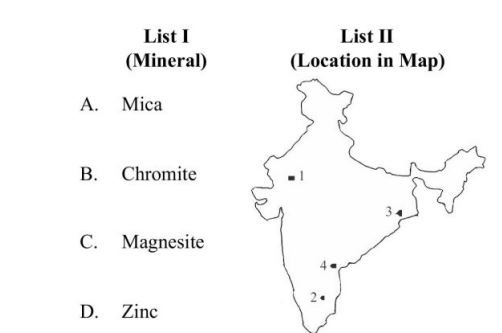Results
#1. Match the following
List-I (Ore) — List-II (Metal)
A. Limonite — 1. Copper
B. Chalcopyrite Pyrite — 2. Uranium
C. Bauxite — 3. Iron
D. Monazite — 4. Aluminum
Codes : A B C D
#2. Geothermal energy is basically
#3. Which one of the following is a fossil source of energy?
#4. Coking coal is a vital input in
#5. Match List-I with List-II and select the correct answer using the codes given below.
List-I (Iron Ore Areas) — List-II (States)
A. Dalli Rajhara — 1. Odisha
B. Kudremukh — 2. Jharkhand
C. Badam Pahar — 3. Karnataka
D. Noamundi — 4. Chhattisgarh
Codes : A B C D
#6. Consider the following statements with regard to the mining industry of India
1. The spatial distribution of minerals is uneven.
2. The mining industry since colonial days has been export oriented.
Which of the statements given above is/are correct?
#7. The ore of Aluminium is
#8. The mineral oil was first discovered in India in
#9. Which type of rocks in India produces manganese?
#10. What is Khetri in Rajasthan famous for?
#11. The state of India having almost monopoly in the production of chromite is
#12. The largest reserve of crude oil in India is found in
#13. Which one of the following states has higher potentials for solar energy?
#14. Jadugoda is famous for which of the following?
#15. Match the following two lists and select the codes given below:
List-I (Minerals) — List-II (Location)
A. Coal — 1. Bhandara
B. Gold — 2. Karanpura
C. Mica — 3. Hutti
D. Manganese — 4. Nellore
Codes : A B C D
#16. Match List I with List II and select the correct answer using the code given below the Lists :
List-I (Mineral) — List-II (Mine)
A. Bauxite– 1. Balaghat
B. Copper — 2. Korba
C. Iron ore — 3. Singareni
D. Coal — 4. Keonjhar
Codes : A B C D
#17. Match List I with List II and select the correct answer using the code given below the lists:
List I (Mineral) — List II (State)
A. Bauxite — 1. Andhra Pradesh
B. Mica — 2. Orissa
C. Copper — 3. Madhya Pradesh
D. Zinc — 4. Rajasthan
Codes : A B C D
#18. Consider the following coal mines of India :
1. Bokaro
2. Adilabad
3. Raniganj
4. Bishrampur
Select the correct sequence of the above from east to west
#19. Which one of the following is a non-renewable resource?
#20. Which one of the following districts does not have a gold field?
#21. Which one of the following oil fields of India is the oldest and still producing oil?
#22. In which one of the following is higher percentage of carbon found?
#23. Match the following
List I (Place) — List II (Famous for)
A. Balaghat — 1. Oil field
B. Katni — 2. Iron ore
C. Singrauli — 3. Manganese
D. Kalol — 4. Bauxite
5. Coal
Codes : A B C D

#24. In the map given below four petrochemical centres are marked with numbers. Match them with the following four places and select the correct answer using the code givenbelow
#25. Why is Himalayan region poor in mineral resources?
#26. After a ban on unscientific coal mining and transportation of coal in this region by the National Green Tribunal, many of those engaged in the activity have been switching to turmeric farming for their livelihood. The region referred above is
#27. Which one among the following places is not an iron-ore mining area?

#28. Match List-I with List-II and select the correct answer using the code given below the list.
#29. Which one of the following rock systems in India is the main source of coal deposits?
#30. Bishrampur is famous for the mining of
#31. Match List – I with List – II and select the correct answer from the codes given below the lists :
List I (Region) — List II (Mineral)
A. Badam Pahar — 1. Copper
B. Koderma — 2. Iron ore
C. Musabani — 3. Petroleum
D. Ravva — 4. Mica
Codes : A B C D
#32. 32. Consider the following statements—
Assertion (A) : National resources are those resources that exist in a region and can be used also in future.
Reason (R) : The development of an actual natural resource depends upon the technology and cost Of production.
Select the correct answer from the code given below:
#33. Match List – I with List – II and select the correct answer from the codes given below the lists :
List I (Mining Areas) — List II (Minerals)
A. Gorumahisani — 1. Lead
B. Talcher — 2. Uranium
C. Jaduguda — 3. Iron ore
D. Zaawar — 4. Coal
Codes : A B C D
#34. A country’s natural capital included all of the following except :
#35. Match List – I with List – II and select the correct answer using the codes given below the Lists :
List I — List II
A. Ukai — 1. Jharkhand
B. Patrapu — 2. Gujarat
C. Satpura — 3. Maharashtra
D. Dabhol — 4.Madhya Pradesh
Codes : A B C D
#36. In India, coal is found in the geological formation of—
#37. Which metal is found at the following places-Hutti, Kolar and Ramgiri in India?
#38. Which one of the following combinations of the districts, shows the correct sequence of magnesite deposits in Uttarakhand?
#39. Which one of following groups of states accounts for about 90% of the annual coal production in India?
#40. Consider the following statements—
1. Balaghat is known for its diamond mines.
2. Majhgaon is known for its manganese deposits.
Which of the statements given above is/are correct?
#41. At which of the following places the Copper Industry is located?
#42. Which of the following Iron ores is mined at Bailadila?
#43. Black revolution is related to the—
#44. Which mineral is mined in Turamdih?
#45. Bentonite deposits in Jharkhand are found in—

